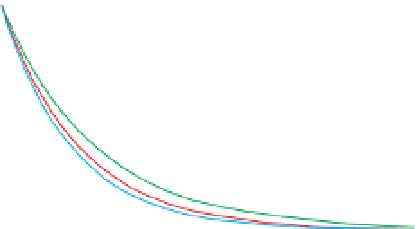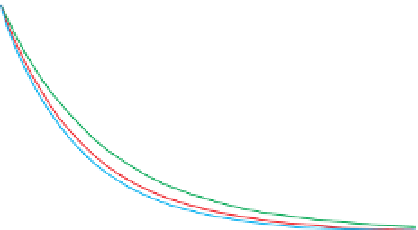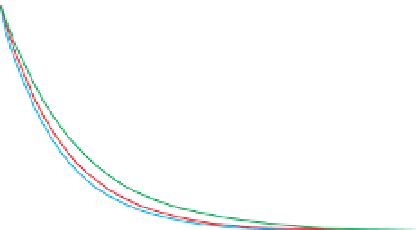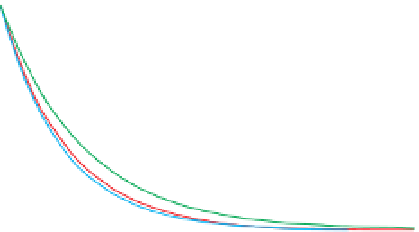Geoscience Reference
In-Depth Information
4.2.4
Measurement units
100
Air,
r
= 0.0013 g/cm
3
80
A variety of units are used for measuring radioactivity. The
Curie (Ci) is defined as the disintegration rate of one gram
of radium, equal to 3.7
60
10
10
radioactive disintegrations
per second. In the SI system of measurements, one disinte-
gration per second is called a becquerel (Bq). Intensity of
radiation can also be measured in terms of the quantity of
radiation absorbed per unit volume or mass of a material,
the measurement unit being the roentgen (R). Although
these units are of
2.62 MeV
1.76 MeV
1.46 MeV
40
20
90% attenuation
0
0
200
400
600
800
1000
Thickness (m)
100
c com-
munity, they are rarely used in exploration geophysics,
where it is usual to measure count rate. This is the number
of emissions measured by the detector in a speci
ed time
interval known as the integration period or integration
time. The integration period is usually one second (giving
the number of counts per second
cially recognised by the scienti
Water,
= 1.00 g/cm
3
80
r
60
2.62 MeV
1.76 MeV
1.46 MeV
40
20
90% attenuation
-
cps) or one minute
0
0
20
40
60
80
100
(giving counts per minute
cpm). Count rates measured
during a radiometric survey depend on the integration
period, the instrument used, survey variables such as the
elevation of the detector, and even the weather; so the
resulting dataset is a series of relative measurements.
Modern survey instruments measure not only the
number of radioactive emissions, but also their energies.
The energy of the radioactive emissions is measured in
electron volts (eV), this being the energy acquired by an
electron when accelerated through an electrical potential of
one volt. However, this unit is too small for practical
purposes so energies are normally expressed as millions
of electron volts (MeV), i.e. 10
6
eV. As described later,
instruments are calibrated to enable the conversion of the
measured counts, in different energy intervals, to concen-
trations of the radioactive elements comprising the radio-
active source. The units for radioelement concentrations
are percentages or parts-per-million (ppm). This presents
the data in a more geologically meaningful form. It also
allows the results of different surveys to be directly com-
pared. The data from the older uncalibrated surveys are
typically presented as count rates, with the unfortunate
consequence that it is dif
cult to compare data between
different surveys.
Downhole radiometric data may be presented as cps, or
if the logging tool is calibrated, in American Petroleum
Institute (API) units. API units have no particular signifi-
cance, merely representing an arbitrary standard to enable
comparison of different datasets. API units are normally
used in the petroleum industry, but count rates are more
commonly used by the mineral industry.
-
Thickness (cm)
100
80
Overburden,
r
= 2.00 g/cm
3
60
2.62 MeV
1.76 MeV
1.46 MeV
40
20
90% attenuation
0
10
20
30
40
0
Thickness (cm)
100
80
Rock,
r
= 2.67 g/cm
3
60
2.62 MeV
1.76 MeV
1.46 MeV
40
20
90% attenuation
0
10
20
30
40
0
Thickness (cm)
Figure 4.4
Attenuation of
γ
-rays of different initial energies by
various materials encountered in the geological environment. The
curves show the intensity of the
γ
-radiation after passing
through a given thickness of the materials, relative to their initial
intensity. Based on data in Grasty (
1979
). Note the different
horizontal scales.
attenuation over that of a dry overburden. Upon entering
the atmosphere the
-rays are subject to much less
attenuation, although radiometric measurements must
stillbemadewithinafewhundredmetresoftheground
surface in order to detect radiation of terrestrial origin.
γ



































































































Search WWH ::

Custom Search